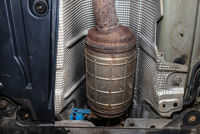Posted on February 15, 2021

The discovery of palladium over 200 years ago was slow and painful. This shiny white element was first thought to be an alloy of platinum, and after much scientific research and discussion, it became a platinum group metal or PGM.
Fast forward a few centuries, and palladium is now more expensive than platinum or even gold. Because of the value and the cost of mining, there is great interest in seeking out scrap palladium.
Most of the palladium extracted around the world is a byproduct of other metals like nickel and platinum. The two largest miners of palladium, Russia and South Africa, mine over 180 tons a year. The U.S. and Canada make up a little over 32 tons in palladium production, though North America and China are the top consumers [8].
So, for consuming countries, it makes sense for them to recycle palladium in order to remain competitive. Since the year 2000, over 67 tons of palladium have come from recycling catalytic converters.
Palladium is a rare PGM, and finding new natural resources is getting more difficult and expensive. This is why more industries are looking for an alternative source ” they want to buy your scrap palladium back.
Everyone wants to know where to find scrap palladium. Palladium was once a worthless byproduct of mining platinum. Now, sourcing scrap palladium is a big business ” over the last five years, recycling to get palladium has become cheaper than mining for it.
If you want to find scrap palladium, you need to begin by looking at the applications industries have for it. The most common use is for making the catalytic converters for gasoline cars.
A scrap catalytic converter can be worth anywhere from $5 to over $100 depending on age and size.
The older the car the converter came from, the more palladium it will hold due to the increase in the price of palladium over time. Old catalytic converters are dense in toxins, so professionals are careful when extracting the metal.
Older converters have chambers filled with pellets, which are easy to remove from the exhaust system. In comparison, modern converters use a honeycomb matrix with less palladium, making the removal more difficult.
Most companies and individuals will take their scrap to recycling plants. Here, a smelter will estimate the amount of palladium and the other PGMs they can extract. The more the metal is separated before you process it, the better the price will be.
Here is the process for refining basic palladium scrap:
Palladium continues to make its way into new applications. Scientists have so far found uses for the metal in many industries, including electronics, medicine and cars. The precious metal is also common in various items you have around your home and at work.
Here are the main applications for palladium:
Palladium's rise in value over the last 20 years is also due to its unique ability to convert other chemicals as a catalyst [3].
Some examples of industrial use include:
Due to palladium being toxic for humans to ingest, the use in medicine is minimal, though it does form a part of some cancer treatments [5]. Also, at the introduction of the catalytic converter, when the price was low, palladium took over as the key metal in dental restorations like fillings and crowns [6].
Palladium is taking over from platinum for use in jewelry. The white color, strength and tarnish resistance makes it perfect for making white metal, similar to white gold or platinum. This precious metal is also comparable in weight to 14-karat gold, which makes it comfortable to wear.
Some jewelers will stamp 'PD' on their works and show the weight of the palladium. The cost of the metal has picked up interest in high-end jewelry as it is harder than platinum, which makes it better for wedding rings.
Other jewelry that may contain palladium include:
Since the '70s, palladium prices have swelled as green politics have forced carmakers to reduce emissions. By 2017, close to 83% of the demand for the metal went to making automotive catalytic converters, or autocatalysts [2].
Autocatalysts can be the most expensive part of cars. When palladium reaches high temperatures, it reacts with gasoline in the exhaust. Unspent fuel and carbon monoxide in autocatalysts convert to less harmful water and carbon dioxide.
Palladium is a rare material, and since the cost of recycling it is much less than that of mining and refining it, you can expect the prices of this PGM to continue to rise over time.
Article Sources:
1. The Financial Times. 'Pandemic brings palladium's record run to screeching halt,' https://www.ft.com/content/5a4b843b-e199-44e2-b8a1-1d7beac7a7f7. Accessed September 21, 2020.
2. Statista. 'Distribution of global palladium demand in 2017, by main application,' https://www.statista.com/statistics/254543/global-palladium-demand-by-sector/. Accessed September 21, 2020.
3. Royal Society of Chemistry. 'Palladium,' https://www.rsc.org/periodic-table/element/46/palladium. Accessed September 21, 2020.
4. Britannica. 'Hydrogenation,' https://www.britannica.com/science/fat-processing/Hydrogenation. Accessed September 21, 2020.
5. The Pharmaceutical Journal. 'Palladium's uses in health care,' https://www.pharmaceutical-journal.com/news-and-analysis/opinion/blogs/palladiums-uses-in-health-care/10993897.blog. Accessed September 21, 2020.
6. Johnson Matthey Technology Review. 'Palladium in Restorative Dentistry,' https://www.technology.matthey.com/article/48/1/30-31/. Accessed September 21, 2020.
7. Hindawi. 'Recovery and Then Individual Separation of Platinum, Palladium, and Rhodium from Spent Car Catalytic Converters Using Hydrometallurgical Technique followed by Successive Precipitation Methods,' https://www.hindawi.com/journals/jchem/2019/2318157/. Accessed September 21, 2020.
8. Statista. 'Distribution of palladium consumption worldwide in 2019 by region,' https://www.statista.com/statistics/216144/top-world-palladium-consumers-as-percent-of-total-consumption/. Accessed September 21, 2020.
9. Britannica. 'Palladium,' https://www.britannica.com/science/palladium-chemical-element. Accessed September 29, 2020.